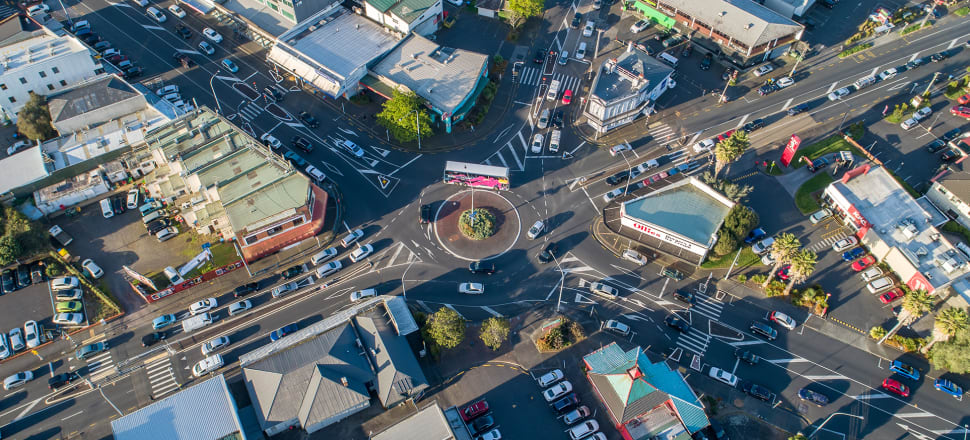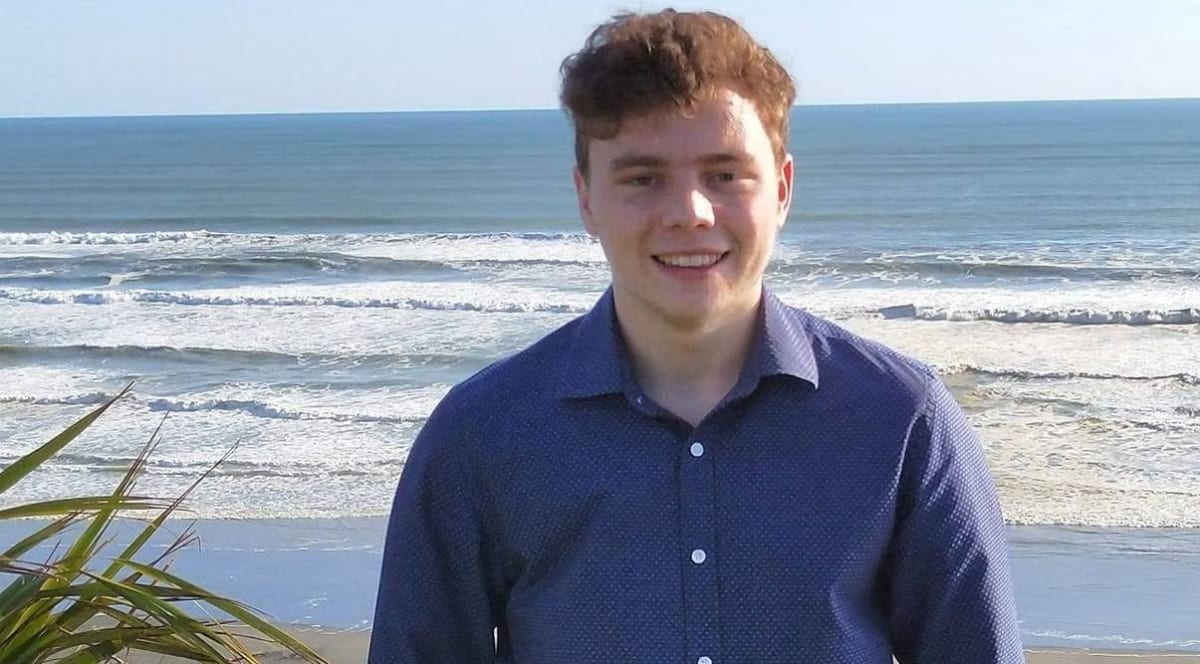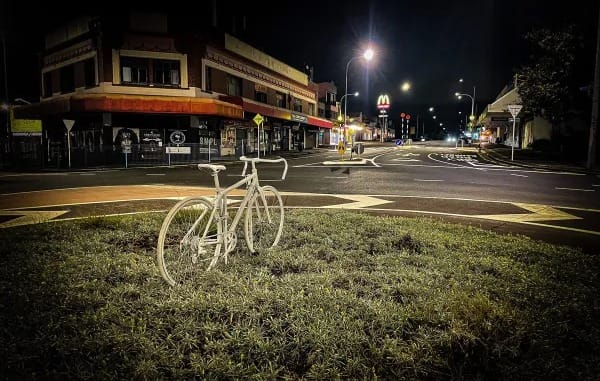
The NZ Transport Agency has quietly hiked the value it places on a human life to $12.5 million, in a far-reaching decision that resets how much government will pay for road and rail infrastructure, and much more. Jonathan Milne reports.
The Royal Oak roundabout. It's not uncommon for motorists unfamiliar with this intersection to freeze up like possums in the headlights, unable to proceed. Often it's sprinkled with sparkling, shattered glass. Locals called it the roundabout of death – until that name became painfully real.
Levi James was cycling down Manukau Rd last year, on his way to see his grandmother.
The roundabout had just been redesigned after a 2018 independent safety review, whose recommendations included safety improvements for cyclists, such as removing on-street parking near the approach to the roundabout and providing dedicated bike lanes. But none of these had been implemented.
READ MORE: * Small print shows impact of inflation isn't 7.2% but 8.7% * The Govt valued your life at $4.53m – until Covid
A driver opened her door on him. The 19-year-old cyclist was thrown into the path of a truck. He died at the scene.
In the days after, councillor Pippa Coom remembered him at a meeting of Auckland Council’s environment committee: "We know that Levi wouldn’t have died if we had actually implemented the parking strategy," she said. "Because he was doored, riding along."
This week, Duncan Laidlaw, the vice-chair of cycle advocacy group Bike Auckland, remembers the moving words of Levi's dad, the day that 100 cyclists gathered to commemorate his son.
"We take a safety first approach," Laidlaw says. "By improving safety on the roads, we actually improve the health and wellbeing of our communities by getting people out there using active transport. And we potentially impact on congestion by ensuring people feel safe to use bikes, or walk around their communities."

Bike Auckland has described James’ death as entirely preventable. "This death could have been prevented by the traffic engineers who have prioritised the movement of cars over the safety of people walking and cycling.”
It's a familiar call: How many more must die?
Because of course, human error is just one contributor to New Zealand's road toll. The safety of our vehicles, and the safety of our roads, are also significant.
Governments and councils can save lives by improving our road and rail infrastructure but, with limited budgets, they must strike a balance. These must be weighed against other imperatives like providing access and parking for new residential and commercial developments, facilitating quicker commutes, accelerating the freight supply chain, or reducing the air pollution and carbon emissions caused by slow-moving traffic in our gridlocked cities.
"One of the arguments against adoption of the higher value was it would result in a shift of resources away from investments in travel time savings and decongestion, and toward road safety features." – Tim Denne et al, Monetised benefits study
Over the past 30 years, there's a strong economic argument to be made that government has not valued human life highly enough; it failed to acknowledge that New Zealanders placed greater value on saving their friends, family and neighbours from injury or death than they did on shaving a few seconds off their morning commute.
Last month, that changed. With no fanfare, no press release, no ministerial statement, the transport agency Waka Kotahi published a document entitled Monetised benefits and costs manual v1.6 April 2023. The 429-page manual is a dense compendium of tables, formulae and, to the layperson, impenetrable economic justifications for obscure policies.
But buried in this manual are two big changes to v1.5, published two years earlier. It raises the value we place on saving time stuck behind a wheel driving to and from work, from $7.80/hr to $19.53 an hour – an increase by a factor of 2½. That figure increases to as much as $36.18/hr if that's what it costs to avoid being stuck in congestion.
And at the same time, it increased an esoteric number called the VoSL – the Value of a Statistical Life – from $4.88m to a somewhat breathtaking $12.5m. That's an even bigger increase.
Value of a Statistical Life (NZ$)
The net effect of these changes is that now, if a road or rail authority wants to decide how to spend its budget, it will measure up the cost of each project against the Value of Travel Time and the Value of a Statistical Life to decide whether sufficient time will be saved, or sufficient pain and grief avoided, to justify paying for the project.
And because those values are so much higher, it will be much easier for an infrastructure project to pass the threshold in the cost-benefit ratio – and so the pressure will go on the Government to fund more projects to make our roads both faster and safer.
The price of life
Placing a dollar value on a human life seems callous.
But it's these benefit-cost ratios that help civil servants, councillors and ministers make fair decisions between competing priorities, rather than just awarding roading projects to whichever pork-barrelling constituency MP shouts the loudest.
It's these analyses that could make the difference to whether or not Auckland Transport removes the carparks on the blind corners outside Ollie's ice cream parlour and The Chip Shop, abutting the Royal Oak roundabout.

Sentencing 24-year-old motorist Hannah Louise Tilsley for careless driving causing death, Judge Belinda Sellars acknowledged the blame was not all hers. This was a "particularly dangerous stretch of road."
Limited upgrades had been made. The road layout partly explained why Tilsley didn’t see James coming on his bike, despite checking, the judge said.
An overdue increase
The VoSL and the value of travel time will be among the numbers NZ Transport Agency feeds into its computers, alongside the likes of the carbon price, to help calculate whether it builds a tunnel under Waitematā Harbour, or extends the northern motorway beyond Warkworth.
These are the numbers Auckland Transport will use to decide whether it's done enough to avoid further injuries at Royal Oak roundabout.
A spokesperson says it completed safety improvements to the roundabout last year, including changes to its shape, replacement of painted median markings with raised traffic islands, new road markings and signage, and a safer and slower environment for all road users – including people outside vehicles.
"The changes to travel time are found to be minimal," he tells Newsroom. "More significant improvements will be considered as soon as our funding allows,"
Auckland Transport not only factors in local road safety statistics when making investment decisions, but also the risk factors associated with that road or area. For example, it's commissioned research into the economic impacts of reducing speeds to safe levels near schools. "This has shown that for an average 20 minute urban journey, there would only be a 14 second travel time increase. When considered against the very real cost of deaths and serious injuries, Aucklanders have told us that they are willing to accept these slightly longer journey times."
Auckland is continuing to survey residents on their priorities. Just this week, the Mayor's Office sent out emails to consult citizens on such gimme questions as whether allowing efficient movement of people and goods, or significantly reducing deaths and serious injuries, is "extremely important" – or something short of that.

In 1991 government researchers completed a survey of 700 New Zealanders to find out what value they placed on safety.
They wanted to measure the amount society would pay for the avoidance of one premature statistical death – and they did it by asking individuals the amount they would pay for safety improvements. They came up with a Value of a Statistical Life of $2m.
A new more thorough survey in 1998 doubled the figure to $4 million – but the government of the day refused to adopt it, seemingly dismayed at the cost implications for road, rail and aviation infrastructure.
So it is that the flawed 1991 survey result has been updated in line with wage inflation, every subsequent year. Extraordinarily, that outdated and discredited survey was still used to decide whether or not to build transport and other infrastructure – until now.
"Due to ‘some unresolved policy issues’, the Government did not adopt the revised VoSL estimate, and the VoSL continues to be based on the value established in 1991," wrote Resource Economics director Dr Tim Denne and his team.
"One of the arguments against adoption of the higher value was it would result in a shift of resources away from investments in travel time savings and decongestion, and toward road safety features."
An authoritative study
The new $12.5m VoSL figure is based on a far bigger, far more robust survey of nearly 8,000 New Zealanders, conducted through 2020 and 2021. The lead authors were Denne, alongside Lincoln University's Professor Geoff Kerr, and Infometrics chief economist Dr Adolf Stroombergen.
Rather than asking such loaded questions as those in the Auckland Mayor's consultation (Do you think motherhood and apple pie are important, very important or extremely important?) this survey works slowly through different measures, asking respondents to place a dollar value on how much they would consider it worth paying to avoid a minor injury, or a serious injury, or to avoid sitting in gridlocked traffic for an hour every day.
It's a methodology that's been honed in similar studies around the world – and it's highlighted just how out-of-touch the old cost-benefit values were with contemporary New Zealanders' priorities.
So is it the case that the Government has now made the decision that it could have made back in 1998 – to give a proper weighting to road safety in deciding which road and rail projects should proceed?
Not quite, says Stroombergen. The effect of raising both the VoSL and the value of travel time is to lower the overall bar for investment – but the weighting tips only slightly towards road safety.
It's interesting to note that the study's authors didn't recommend officials raise the VoSL as high as $12.5m – they simply suggested a midpoint, somewhere about a minimum of $8.1m. Their views are mixed on whether Waka Kotahi has raised the VoSL number too high, thereby giving safety greater weight in decision-making.
Denne says: "Personally, I agree with the approach they have taken,"
Stroombergen is more cautious. "We did not recommend it," he says. "And I don't think we would do that. But that's their choice."
At Te Manatū Waka, the Ministry of Transport, chief economist Joanne Leung says no policy decision has been made to prioritise travel time savings and decongestion ahead of road safety (or, indeed, the reverse).
The injury values were set at the mid-points of the ranges determined in the latest research by Denne and his team. That decision was made by roading agency Waka Kotahi, with input from Te Manatū Waka and the Treasury.
As well as the $12.5m Value of a Statistical Life (up from $4.88m in 2021), the agencies have valued the avoidance of serious injuries in a crash at $660,100 (up from $488,900) and the avoidance of minor injuries at $68,000 (up from $19,600). "These values are then used to calculate the costs of different types of crashes depending on speed limit, movement category, vehicle type and traffic mix," Leung says.
(When additional social costs to the community are added in, the value is $13,354,100 per fatality, and $1,315,900 per reported serious injury).
Asked whether the effect of increasing the VoSL more rapidly than the value of travel time was to prioritise safety, she replies: "The values for injuries and travel times are applied in the benefit-cost ratio calculations and there is no bias towards a specific outcome from those calculations."
Not always a trade-off
These numbers can feel very removed from real life. But for Stroombergen, it's useful to put them in context.
The Royal Oak roundabout is one example where change could be made. Or, he gives an example from his own neighbourhood in Wellington.
"From the suburb of Hataitai into the Mt Vic Tunnel, that's a fairly tricky intersection. You've got to merge into Ruahine Street, and it's tricky. They've been talking about doing all sorts of things, but nothing's been done. It's part of 'Let's get Wellington not moving!'
"I've never come across a death there, but there are certainly some bangs."
His analysis shows the two biggest factors in reducing road accidents are better cars and better roads. "They have such a big effect," he says. "And I suspect that what's going to continue to deliver a decline in accidents numbers from now on – better roads, separated median barriers, safer cars with ABS and everything.
"You build a better road and you'll probably get better efficiency and better safety. So there's there's not necessarily a trade off there at all. If something comes out of this, I would like to see us build safer and more efficient roads."
Correction: The value of travel time has been amended to the economic value used in benefit-cost assessment for commuting trips, rather than the behavioural value.







